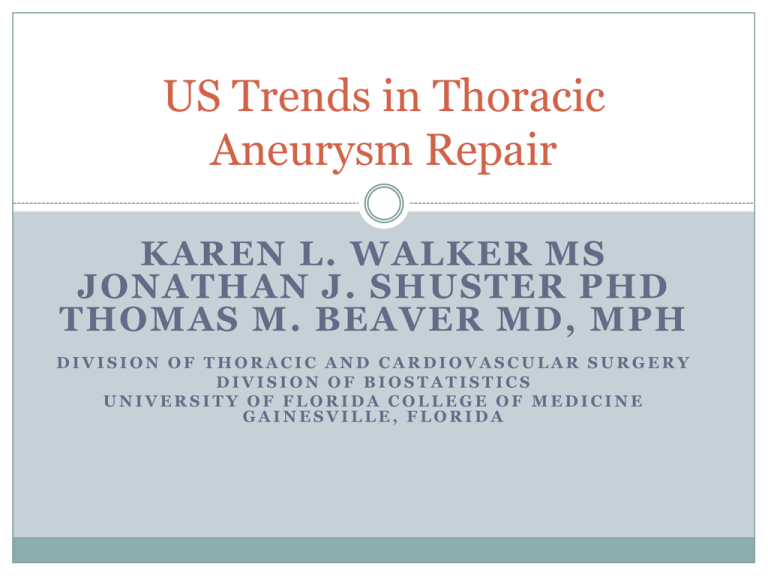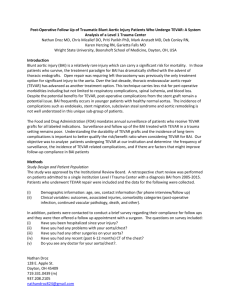
US Trends in Thoracic
Aneurysm Repair
KAREN L. WALKER MS
JONATHAN J. SHUSTER PHD
THOMAS M. BEAVER MD, MPH
DIVISION OF THORACIC AND CARDIOVASCULAR SURGERY
DIVISION OF BIOSTATISTICS
UNIVERSITY OF FLORIDA COLLEGE OF MEDICINE
GAINESVILLE, FLORIDA
Objective
National practice patterns for thoracic aneurysm
repair are largely unknown because the US does not
have a thoracic aneurysm endovascular repair
registry.
The National Inpatient Sample was employed to
determine the effects of the 2005 FDA approval of
thoracic aneurysm endografts on the surgical
management of patients with thoracic aneurysms.
National Inpatient Sample (NIS)
20% stratified sample of US hospital discharges
8 million hospital discharges
Can be weighted to generate national estimates
Can be used to assess in-hospital complications,
mortality and outcomes.
Cannot be used to assess long-term outcomes.
Methods
Population
ICD-9 codes were used to identify all thoracic aneurysm cases with
endovascular repair (39.73) or Open Repair (38.45) procedure code.
Exclusion criteria were applied enabling the selection of only
unruptured descending thoracic aortic aneurysm repairs.
NIS was used to generate repair rates which were
adjusted for annual population estimates.
Meta-analysis controlling for center was performed to
compare differences in age, comorbidities,
complications, and LOS for Open repair vs. TEVAR
(Thoracic EndoVascular Aortic Repair) .
Results:
An increase in diagnosis of Thoracic aneurysms followed
introduction of 16 slice CT scanners in 2003
An increased overall repair rate of thoracic aneurysms
followed 2005 FDA approval of thoracic endografts (TEVAR).
Increased adoption of Thoracic endograft repair may follow
previous trends in Abdominal endograft repair (EVAR).
TEVAR (Thoracic EndoVascular Aortic Repair) patients were
older with more comorbidities, but had shorter LOS, fewer
complications and decreased mortality.
Diagnosis Rate of Unruptured Thoracic Aneurysms per 1,000,000 Adjusted for
US Census Bureau Annual Population Estimates
25
160
140
20
120
15
100
80
10
60
40
5
20
0
0
2000
2001
2002
2003
Unruptured Thoracic Aneurysms
2004
2005
2006
Thoracic CT Scans
Thoracic CT Scans Utilization per 1,000,000
Adjusted for US Census Bureau Annual Population Estimates
Thoracic CT Scan Utilization and Diagnosis of
Unruptured Thoracic Aneurysm
Unruptured Descending Thoracic Aneurysm Repair per 1,000,000
Adjusted for US Census Bureau Annual Population Estimates, 18+
Years
Trends in Unruptured Descending
Thoracic Aneurysm Repair
12
10
8
6
4
2
0
2000
2001
2002
Open Repair
2003
TEVAR
2004
2005
Total Repairs
2006
Trends in Abdominal Aneurysm Repair
Principle Procedure per 1,000,000
(Adjusted for US Census Bureau Annual Population Estimates)
180
160
140
120
100
80
60
40
20
0
1995
1996
1997
1998
1999
Open Repair
2000
2001
EVAR
2002
2003
2004
Total Repairs
2005
2006
Comorbidities in 2006 Cohort:
Only Those Institutions in 2006 NIS Cohort Performing Both TEVAR and Open Repair
Open Repair
TEVAR
Relative Risk
P-Value
Current or Previous Smoker
12.63 %
36.37 %
0.34
0.002
Chronic Kidney Disease
2.03%
12.05%
0.16
0.004
Diabetes
5.69 %
16.85 %
0.33
0.03
Hypertension
76.18 %
78.63 %
0.96
0.72
Coronary Artery Disease
21.15 %
25.06 %
0.84
0.64
Previous Myocardial
Infarction
3.65 %
6.09 %
0.60
0.51
Congestive Heart Failure
10.40 %
9.01 %
1.15
0.72
COPD
27.47 %
32.27 %
0.85
0.51
Peripheral Vascular Disease
0%
5.07 %
0
.
Complications in 2006 Cohort:
Only Those Institutions in 2006 NIS Cohort Performing Both TEVAR and Open Repair
Open Repair
TEVAR
Relative Risk
P-Value
Cardiac Complication
7.13 %
1.21 %
5.85
0.01
Respiratory Complication
23.37 %
8.28 %
2.81
0.01
Ventilation > 96 hrs
13.41 %
1.97 %
6.78
0.01
Transfusion
32.52 %
15.77 %
2.06
0.006
Hemorrhage
7.13 %
3.45 %
2.06
0.38
Acute Renal Failure
8.35 %
3.51 %
2.37
0.13
Postoperative Stroke/TIA
3.65 %
2.65 %
1.37
0.67
Paraplegia
0.40 %
0.73 %
0.55
0.63
Peripheral Vascular Complication
2.43 %
4.60 %
0.52
0.55
Graft Problem
2.84 %
4.75 %
0.59
0.59
Mean Age and Length of Stay:
Only Those Institutions in 2006 NIS Cohort Performing Both TEVAR and Open Repair
Open Repair
TEVAR
P-value
TEVAR
Patients
Age
61.5
69.7
<.01
OLDER
LOS
9
6
<.01
Decreased
LOS
Mortality
9.79%
1.15%
<.01
Decreased
mortality
Conclusions
TEVAR has been rapidly adopted in the US
resulting in increased treatment of thoracic aortic
aneurysms.
Trends in abdominal aneurysm repair may
foreshadow future trends in thoracic aneurysm
repair.
Despite older age and comorbidities, TEVAR had
better outcomes and shorter hospital stays.
Vigilant surveillance of TEVAR patients is
warranted because the long-term outcomes are
unknown.








